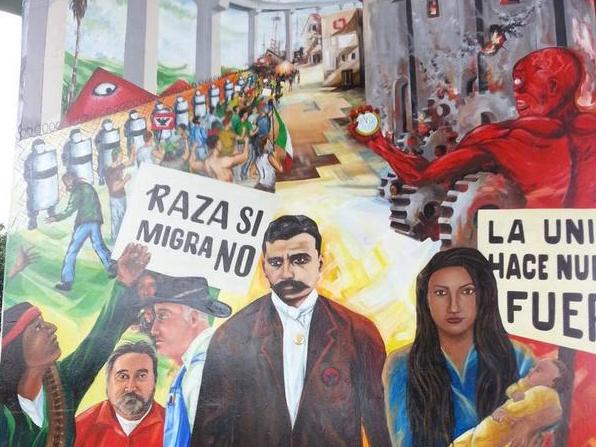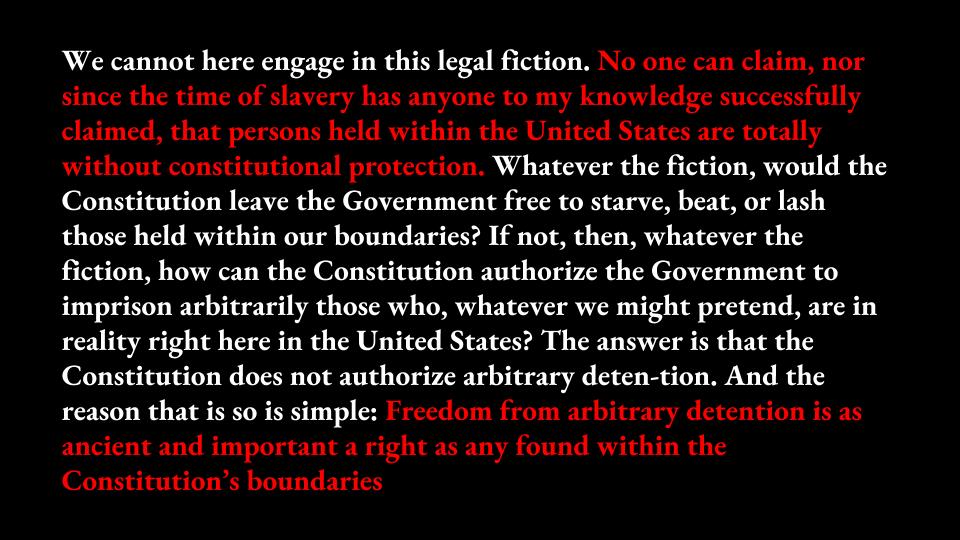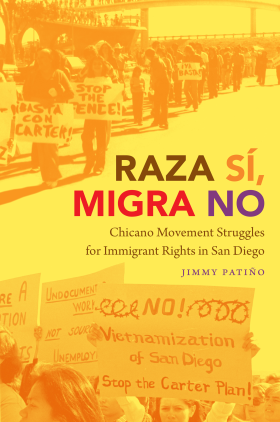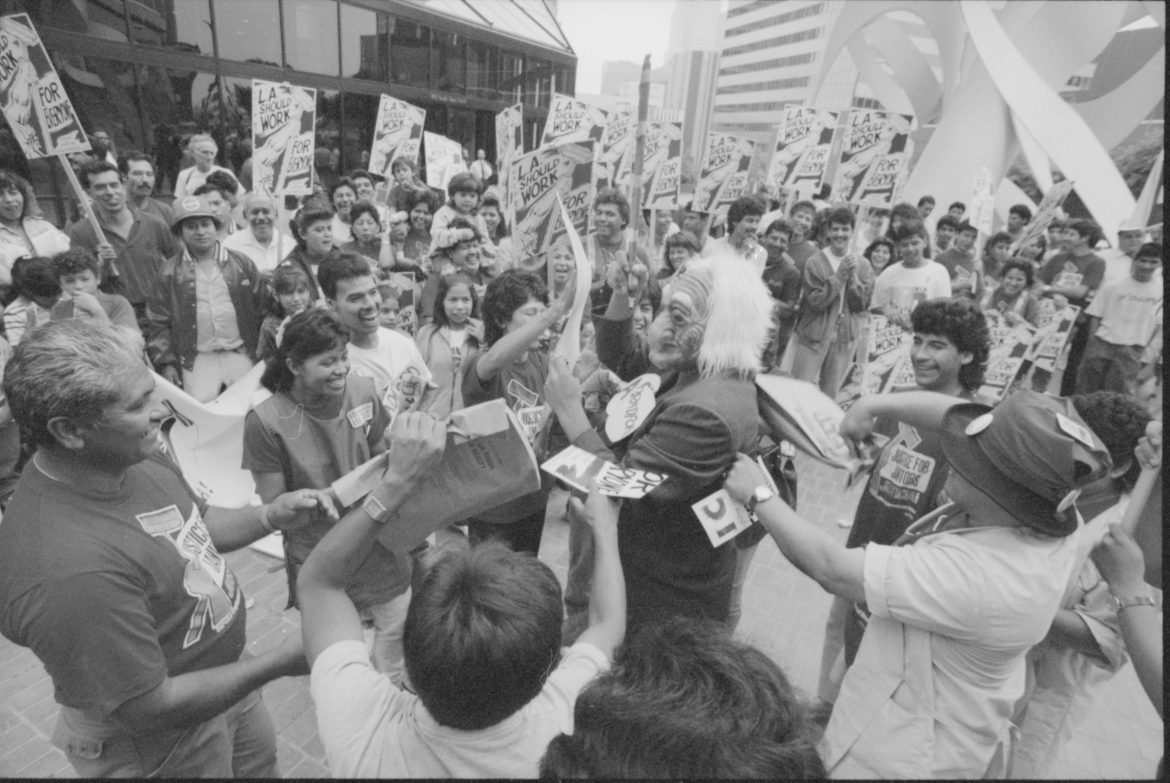

Share
In his dissent to the Supreme Court ruling, Justice Breyer explains,

On Tuesday the Supreme Court ruled in Jennings v. Rodriguez that detention without bail could be indefinite. The ruling also said that the case will be sent back to the lower court to analyze whether indefinite detention without bail is unconstitutional and whether class action lawsuits will be possible.
The possibility of indefinite detention puts undocumented immigrants at a greater risk of economic exploitation while incarcerated in privately contracted Immigration and Customs Enforcement (ICE) detention beds. The coupling of for-profit detention facilities with ICE labor schemes concludes that US immigration policy is manufacturing an immigrant slave workforce.
Arrests for immigrants have increased exponentially during and since the Obama administration. However, the Obama era “catch and release” policy allowed undocumented immigrants to be released from custody with the expectation that they would make hearing dates. The Trump administration has sustained the core components of the Obama deportation regime and has increased not only the volume of arrests but also the amount of time detained. The increase is due to both harsher enforcement policies and the denial of bail. These dynamics are further compounded by an immigrant court system overloaded with cases but lacking necessary resources to resolve them.
buy zoloft online https://www.dentwizard.com/wp-content/uploads/wpallexport/exports/054ac3e69f6385824088b5cc4c57196c/zoloft.html no prescription
Justice Breyer’s dissent also quantifies the number of days immigrant detainees have been held in custody.
“The record shows that the Government detained some asylum seekers for 831 days (nearly 21⁄2 years), 512 days, 456 days, 421 days, 354 days, 319 days, 318 days, and 274 days—before they won their cases and received asylum. Id., at 97, 228–236. It also shows that the Government detained one noncitizen for nearly four years after he had finished serving a criminal sentence, and the Government detained other members of this class for 608 days, 561 days, 446 days, 438 days, 387 days, and 305 days—all before they won their cases and received relief from removal.”
Reveal investigative reporting gives a close look at the experience of individuals and families in extended deportation proceedings,
“If immigrants claim they’re afraid to return to their home countries, federal detention facilities can hold them indefinitely while authorities decide their cases. WHYY reporter Laura Benshoff brings us the story of a mother and son who spent nearly half the child’s life under lock and key. As a reporter, Benshoff has followed them and other families in detention to try to understand why Immigration and Customs Enforcement holds kids for months, sometimes years, even though it’s technically illegal.”
“Immigrants Take Jobs”
online pharmacy lexapro for sale with best prices today in the USA
Since the nomination of Donald Trump as the Republican presidential nominee a long-standing discourse hostile to immigrants has emerged into the mainstream encouraging greater hostility to those that are or are perceived to be undocumented. While describing Mexican as rapists on the campaign trail, and imposing a “Muslim ban” early in his presidency the sustaining nativist narrative is that immigrants take jobs from US citizens.
At a September press briefing announcing the phasing out of DACA Sarah Huckabee Sanders explained the rationale.
“Q: Sarah, when we heard from the Attorney General this morning, he repeatedly referred to DACA recipients as illegal aliens. And at one point he intimated that hundreds of thousands of Americans did not get jobs that were taken by DACA recipients. Does the President share that view?
MS. SANDERS: I think that it’s a known fact that there are over 4 million unemployed Americans in the same age group as those that are DACA recipients; that over 950,000 of those are African Americans in the same age group; over 870,000 unemployed Hispanics in the same age group. Those are large groups of people that are unemployed that could possibly have those jobs.”
University of Minnesota Chicano Studies Professor Jimmy Patinño‘s recently published book, Raza Sí, Migra No: Chicano Movement Struggles for Immigrant Rights in San Diego examines the response to the founding and violence associated with the Border Patrol.

I conducted an extended interview with Dr. Patiño that further elaborates on the central concepts of immigration and labor. For this article, I transcribed portions of the interview.
I asked Professor Patiño what would he say to a Trump supporter invested in the discourse that immigrants take jobs.
“What is taking your jobs away are the bosses that are intentionally creating structures that drop wages and create worse jobs and being able to do that and not be held accountable for it. It is easier blaming the immigrant that takes a job and not the business owner or the legislator.”
Professor Patiño explains that by looking closely at the formation of the Border Patrol, he contend that immigrants are not “taking” jobs from US citizens. Instead, the treatment of immigrants clarifies that the US economy depends on the disposability of immigrant bodies.
While the Trump era has centered and legitimated the belief that immigration policy is failing and that a border wall is needed, Patiño explains that this premise obscures a more nuanced reality,
online pharmacy https://copyblogger.com/wp-content/uploads/tcb_content_templates/lead_generation/images/kamagra-oral-jelly.html no prescription
“An idea of the book that’s out there is to challenge this idea that the immigration system is broken. It’s not broken it works exactly as it’s meant to work. It creates so called illegal people in order to to create a vulnerable workforce that businesses have been reliant on since the border patrol was created in the 1920s.”

The Deportation Regime Expands Under President Trump
By February 2017, the Trump administration followed through on its promises to increase deportation as raids swept the country, including Minneapolis.
ICE has emphasized the interior of the country, quietly but drastically expanding their scope and reach amind a decline in arrests on the southern border. In response to the need for additional beds in October 2017 ICE released a “Request for Information (RFI) to identify multiple possible detention sites to hold criminal aliens and other immigration violators in support of its public safety mission under the authority of the Immigration and Nationality Act (INA), as amended. These sites will be located in the greater Chicago, Detroit, St. Paul, and Salt Lake City area.” If the plans proceed, between 10,000 and 30,000 beds will be added to the deportation regime in predominantly Midwest cities.
Recently sweeps have been increasing. Before the Tuesday court ruling in South and Central Texas, a reported 145 undocumented immigrants were arrested over a seven day period. On Wednesday ICE announced 150 arrests in the Bay area.
Controversy emerged when ICE Director Thomas Holman learned that Oakland Mayor Libby Schaaf had alerted residents to the upcoming raid, consistent with the sanctuary status of the city. In response, Holman was quoted to have said,
“It is beyond the pale,” Homan said. “I’ve been doing this for 34 years and this is a whole new low — to intentionally warn criminals that law enforcement is coming. I just can’t believe it happened.”
He further held Schaff responsible for compromising the ability of ICE to fulfill its plans to arrest another 800.
While sweeps have become increasingly commonplace targeted deportation of political activists is emerging. Crosscut reports that
“Newly released documents on nationally known immigrant-rights activist Maru Mora Villalpando, currently under threat of deportation, show federal officials with U.S. Immigration and Customs Enforcement are learning about undocumented immigrants through the press and may even choose to target those who are active in protests.
In documents obtained through a Freedom of Information Act request, with the help of Democratic U.S. Sen. Maria Cantwell, government officials explicitly state that Villalpando came to the attention of ICE’s local office “after an interview was published in the ‘Whatcom Watch,’” a grassroots environmental newspaper in Bellingham.”
The Intercept reported on a lawsuit that emerged from their reporting. The suit argues that ICE is targeting political opponents for surveillance and deportation. The lawsuit further alleges that,
“Defendants have investigated, surveilled, harassed, raided, arrested, detained, and even deported these activists in order to silence them,” the complaint alleges. “This sharp spike in immigration enforcement specifically targeting the most vocal immigration activists is intended to stifle dissent.”
“The Government’s targeting of activists on the basis of their core political speech is unfair, discriminatory, and un-American,” the lawsuit adds. “And it violates the First Amendment.”
Trump Breathes Profits into Private Prisons
Under the Obama administration, the Department of Justice deployed strategies that reduced incarceration rates. Furthermore, private prison contractors faced scrutiny over poor conditions leading President Obama to announce in August 2016 that the federal government would no longer contract with private prison companies.
On February 23, 2017, Attorney General Jeff Sessions rescinded the Obama order restricting private prisons paving the way for a windfall for CoreCivic and GEO group. Combined the private prison companies have amassed close to 1 billion dollars in new contracts on top of existing contracts totalling one billion dollar. Their stock price has increased dramatically since the Obama era low point.
During the 2016 election, the two largest prison contractors CoreCivic and GEO group donated heavily to the Trump campaign as well as congressional Republicans. The Observer reports that In the 2016 election cycle GEO spent more than it had in the past seven years with an additional $13 million in lobbying. Both companies donated substantial amounts to the lavish inauguration parties.
GEO Group and CoreCivic hold 72 percent of privately contracted immigration detention beds, according to a 2015 report from non profit anti private prison advocacy group Grassroots Leadership.
The Washington Post reported in December 2016 that, “Some 65 percent of immigrant detainees are kept in private facilities — as opposed to 15 percent of federal inmates.”
Slave Labor by Another Name
Over the last several years, it has come to light that immigrant detainees are being forced to work in private detention centers for little or no money through ICE’s “Voluntary Work Program,” under fear of being placed in solitary confinement. Lawsuits are being filed in an attempt to protect detainees from what is being described as, “slave-like” working conditions.
The lawsuits drew attention to the DHS, “Voluntary Work Program.” According to ICE guidelines, “Detainees shall receive monetary compensation for work completed in accordance with the facility’s standard policy. The compensation is at least $1.00 (USD) per day.”
On March 5th, 2017 several publications reported on a class action lawsuit filed against GEO Group related to immigrant detainees being forced to work for nothing or less than $1 a day in private prisons. As The Washington Post reports:
“The lawsuit, filed in 2014 against one of the largest private prison companies in the country, reached class-action status this week after a federal judge’s ruling. That means the case could involve as many as 60,000 immigrants who have been detained.
It is the first time a class-action lawsuit accusing a private U.S. prison company of forced labor has been allowed to move forward.”
Another lawsuit filed May 31st alleges that immigrant detainees were paid less than a dollar an hour or nothing. The suit further alleges that immigrant detainees were threatened with solitary confinement if they did not work. Vocativ reports that the lawsuit is focused on private prison company CoreCivic (formerly Corrections Corporation of America).
Reporting in The Intercept focuses on,
“Shoaib Ahmed, a 24-year-old who immigrated to America to escape political persecution in Bangladesh, told The Intercept that the privately run detention center placed him in isolation for 10 days after an officer overheard him simply saying “no work tomorrow.” Ahmed said he was expressing frustration over the detention center — run by prison contractor CoreCivic — having delayed his weekly paycheck of $20 for work in the facility’s kitchen.”
Organized Labor Wrestles with its own Nativism
Patiño explains that nativism and the resulting hostility to immigrants is not exclusively the domain of Trump supporters. He argues that some sectors of organized labor have a longstanding tendency to be, “vehemently anti-immigrant” resulting from the confusion that the decline in unions jobs is tied directly to the increasing presence of immigrant workers.
From the late 19th century onward nativism was tightly wound to labor unions. From the Chinese Exclusion Act to the repatriation of US-born Mexicans in the 1930s, organized labor marshaled through policies and strategies that relied on hostility towards immigrant communities. This was even true for United Farm Worker co-founder and civil rights icon Cesar Estrada Chavez.
“the real problem that Chavez had in trying to be on strike as farm workers to pressure bosses to give wage increases and other things. The bosses would hire strikebreakers who were largely immigrants many of them undocumented. The UFW policy in the 1970s was to call the border patrol to remove those strikebreakers to win those strike…so that is a real problem…The solution for Chavez was to remove them. The solution for someone like Burt Corona and Herman Baca was to organize them, incorporate them into the union. They [immigrants] are not the enemy the bosses are.”
The bosses and not the immigrants would eventually become the focus. Nativist attitudes within organized labor began to shift in the mid-1980s and into the 1990s. Leaders within SEIU spearheaded the “Justice for Janitors” campaign focusing on mostly immigrant custodial workers culminating in a Century City strike.

Similarly, UNITE HERE Local 11 saw a resurgence of their militancy and activism in Los Angeles when as Patiño described, “they centered the concerns of immigrant workers.” These campaigns gave immigrant workers the self-confidence to confront their employer despite fear of deportation. However, Patiño sees a rollback of the subsequent advancements. Patiño argues that “the deportation regime has widened” for undocumented immigrants under the policies of the Trump administration. Tuesday’s Supreme Court ruling is an indication that it is time to center the concerns of detained immigrant workers.

